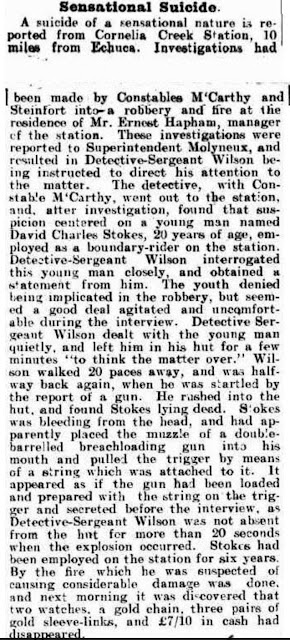This is the story that I've pieced together from newspaper reports.
The manager, Ernest Harpham, of Cornelia Creek reported to police that he had been robbed on the 17th March 1906 and when on 22nd March they went to the sheep station to interview him he said that he'd been awakened at 1 a.m and found Charlie Stokes in the passage. Charlie had been sent to Echuca earlier in the day to pick up a telegram and entered the house to give it to him. As he opened the door into the living room Harpham found that the curtains were ablaze and considerable damage was caused before it was brought under control. The next day the manager found that he had also been robbed of a gold brooch, 2 watches, a gold chain, three pairs of cuff-links, £7/10 in cash and his day and cash books.
Suspicion soon fell on Charlie Stokes because as well as being in the house apparently he owed about five pounds to the station. The assumption was that by destroying the books he was destroying proof of the debt.
The police and the manager went to the Koyuga railway station where they found Charlie on the platform and persuaded him to return to Cornelia Creek. Detective Sergeant Wilson interviewed him in his room and asked him to write a statement. Wilson then left the room and he and two other witnesses, the gardener Thomas Mills and the cook John Irving, stated that he was only out of the room a few seconds when they heard a gun shot. Charlie had killed himself.
At the inquest the policeman said that the gun must have been prepared and hidden because there wasn't time for Charlie to have taken off his coat and hung it up before getting the gun and using his toe to pull the string attached to the trigger.
 |
| Albury Banner and Wodonga Express 30 Mar 1906 |
The day before he died Charlie wrote a letter to his sister (the newspapers don't say which one) claiming to be innocent of the crime and asking for help from his father. The letter was later published in the paper.
 |
| Riverine Herald 2 Apr 1906 |
The inquest returned an open verdict.
For me there are still questions that remain unanswered. Where are the stolen goods? Where was Charlie buried? Was he guilty and if not who was?
******
* Coincidentally the owner of Cornelia Creek, George Simmie, died in Melbourne in the same week aged 78. He was the former MLC for Northern Province.
** Cornelia Creek was subdivided in 1911 but there is a winery currently operating under that name on the original homestead site.
*** My connection with this story is that Charlie Stokes' grandmother, Eleanor Stokes nee Paynter, was a great great aunt of my husband. She was born in the village of Iwerne Courtney, Dorset and when she was 18, in January 1855, she married a local lad called Charles David Stokes. Almost immediately, with her new husband, her parents and siblings she sailed to Australia on the 'Omega', arriving in May 1855.
For this post I was able to use the amazing newspaper resources at Trove.








